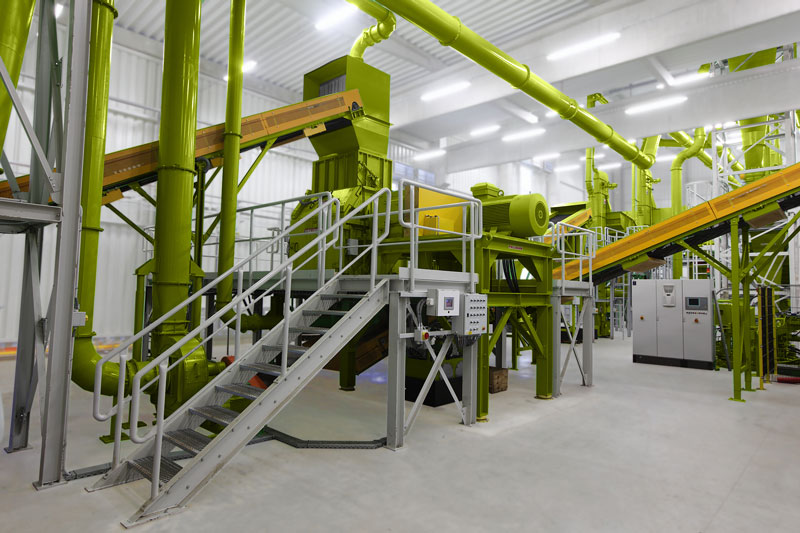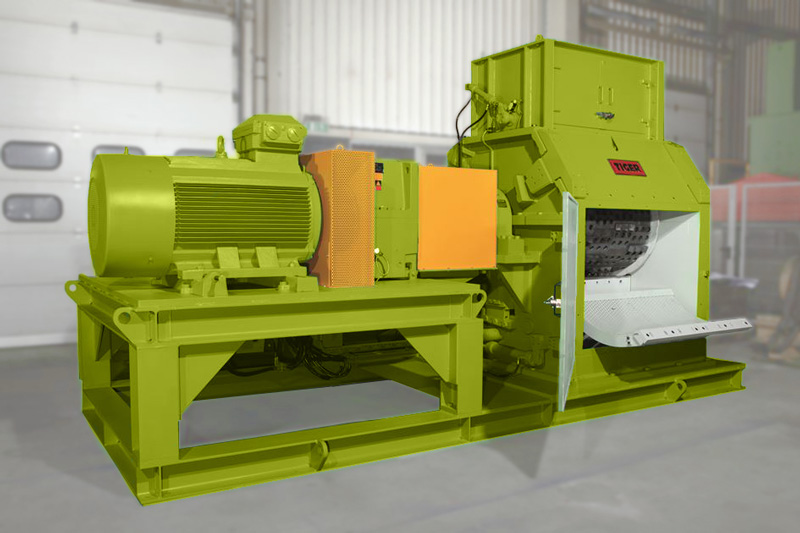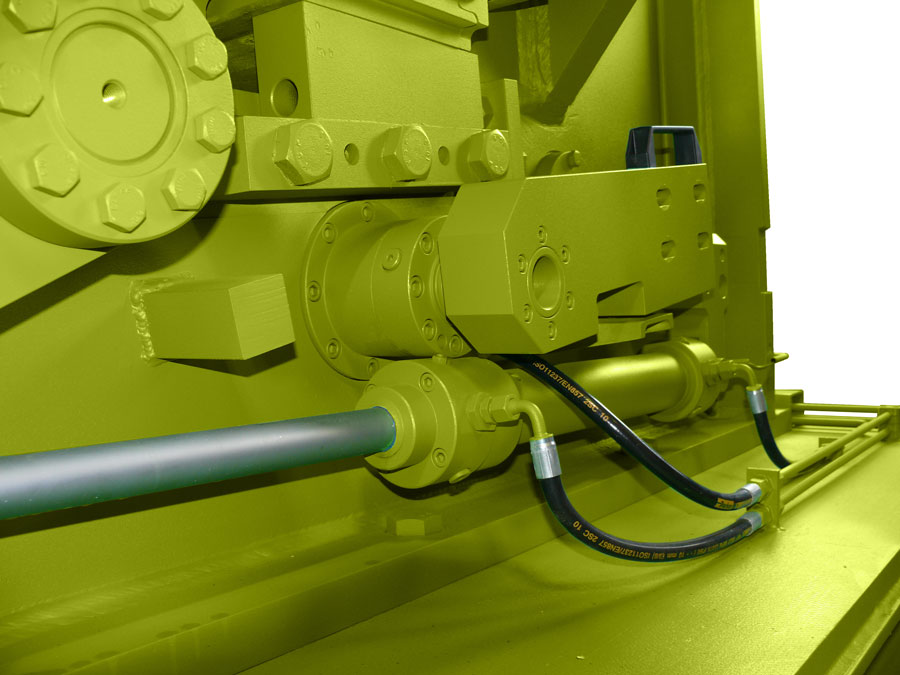Single-shaft shredder in recycling systems
Industrial hydraulic cylinder



Recycling poses high demands
Pallmann with its over 400 employees manufactures its own range of various machine types for the recycling sector in its own special division. The processing of above all composite materials started ten years ago with a plant for vehicle tyres. The individual machines just as the entire system were and are still designed for the most varied composite materials in the scope of special machine and plant engineering: this way, wood compounds – even if they are heavily soiled –, electronic scraps, flooring or conveyor belts can be separated. This also applies for tyres consisting of rubber, steel and textile that are recycled as secondary raw materials with a degree of purity of 98 %. Three to four work steps are typical for the Zweibrücken company: rough shredding to a size of maximum 150 mm, separating the compounds, fine granulation and, if required, ultrafine granulation. In any case, this is one work step less than the market standard. As common in the industry, the general conditions are extreme: large forces shred basically unpredictable materials in an extremely rough environment. All components are subjected to dirt, dust and also chemically aggressive substances. As the flaps, screens, rotors and shredding units have to withstand extreme forces and are very heavy, hydraulics are indispensable. "Especially in the recycling sector, components have to work according to the principle 'install and forget'. This is because the end users of our systems may be working on a different continent and often do not have specialists at hand that can expertly exchange the seal on a industrial hydraulic cylinder," points out Dietrich. "After the corresponding experiences gained with other suppliers, we therefore opted for industrial hydraulic cylinders by Hänchen for sophisticated application fields. For example, they have been in use at a Spanish tyre recycling company for ten years now without requiring any maintenance or showing any signs of wear."
Precision in a rough environment
For the hydraulics specialist Hänchen, precision is the key for such challenges. The decisive factor is that foreign substances and especially ultrafine foreign matter do not enter the inside of the cylinder where they damage seals and piston rods in the long term. The sealing combination is of decisive importance here. Even in the basic design of the Hänchen cylinders, optimum friction properties, low vibration and a minimum stick-slip effect are therefore a matter of course. Amongst other things, these properties result from a design feature which the hydraulics experts in Ostfildern have meanwhile extended to almost all cylinders in the catalogue: they are fitted with a sprayed-on and reworked synthetic guide. The gliding surfaces of these guides dampen vibrations and prevent edge pressure. They furthermore also guarantee a certain absorption of side loads, which is very helpful in the rough application area of the recycling system. An unusually long service life is guaranteed by the high production accuracy and the minimal guide clearance. With the Servocop® sealing combinations used at Pallmann, an additional head-side sealing element ensures practically stick-slip-free movements. With this very low-friction pair of sealing elements, leaks are prevented by an additional pressure-free leak oil connection with terminating leak oil sealing element. This way, very low friction and high sealing capacity can be united in this economic quality solution.
The fact that each cylinder only consists of three basic components and is manufactured with a higher accuracy than the standard category on the market also contributes to the robustness. A thickly chrome-plated and honed piston rod surface guarantees optimum operating characteristics at minimum wear. And the inseparable bond between piston and rod is especially fail-safe and provides outstanding geometric accuracy. In addition, inner honing of the tube guarantees high stability and precision. With these properties, the Hänchen hydraulics fit perfectly in the Pallmann profile: "Quality and state-of-the-art technology are our topmost priority, followed by sustainability through a long service life, maximum system availability even in three-shift operation, as well as easy exchange of parts during the general maintenance interval," is how the development specialist describes his concept. This also applies for the 'Tiger' single-shaft shredder that separates the material compounds in the shredding process. This is a customised machine that is adapted in the scope of special purpose machinery construction: depending on the task, it integrates the upstream shredding tools, different rollers and self-sharpening, especially low-maintenance blades hardened in an in-house developed process – these are a Pallmann patent. The Tiger is designed for a long service life – a standard that the components have to meet as well. Wear and tear parts therefore only include shredding elements like blades – or with other machines the beaters, friction parts and parallel elements. The maintenance interval in case of permanent operation is a lot longer than the standard four weeks. Even though this concept is initially associated with higher purchasing costs, the Zweibrücken company is convinced of its cost effectiveness. Because what counts in the end are the process costs per ton in decades-long permanent operation. This also includes a minimised energy requirement.
Hänchen cylinders in application
The machines shred up to 4 tons hourly of all kinds of shreddable materials to a maximum grain size of 20 mm. Massive, auger-shaped rotor intake rolls move along stator intake rolls powered by a 355 kW motor. They are self-sharpening by regularly reversing, meaning the change of the rotor direction. Here is where the first Hänchen cylinder is in application in the centre of the intake flap section. A largely dimensioned screen is installed in the bottom housing part of the machine. This keeps the material in the processing chamber until it can be discharged through the screen holes. Two additional cylinders move heavy screens that can be folded out if required or when changing blades. These are also constant subjected to environmental influences such as dirt and vibrations. Another industrial hydraulic cylinder presses the blade bar outward for maintenance purposes: it is installed with a stroke of 1,700 mm, a rod diameter of 50 mm and a bore of 80 mm. In normal operation, the piston rod is permanently extended and the shredded material constantly rains over the cylinder. This results in high static forces and vibrations that put a particular strain on the sealing combination. Apart from a special coating and a special position of the sleeves, this component is also a Hänchen catalogue product and therefore has a very positive effect on the price as well as on the reliability. The last cylinder moves a hydraulic motor for turning the rotor for maintenance purposes. With the Tiger, just as with all comparable systems, the hydraulic system by Pallmann including unit and largely dimensioned accumulator is supplied as well.
Together with customers, the specialist for shredding material up to a degree of hardness of 4 can examine shredding processes, test the characteristics of new substances or innovative methods, or develop new machines, systems or shredding solutions – just as in recycling technology. Besides extensive expertise in application-related mechanical, hydraulic and electric engineering, material science, electronics, process optimisation, controller software and sequence programming, we have another ace up our sleeve: our own pilot plant station with 150 different machines. Tests can be performed here and prototypes tested. This makes Pallmann more reliable and efficient than most companies in this market. Tyre recycling, in which the Tiger with the Hänchen cylinders is used, shows this clearly: "Ten years in three-shift operation without problems show that our concept had paid off," Dirk Dietrich proudly reports. The hydraulics components by Hänchen are significant quality components in this context.
© Hänchen 2014

